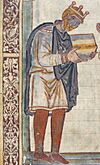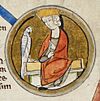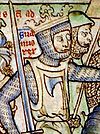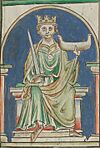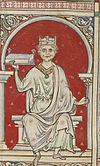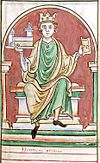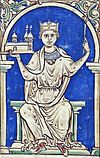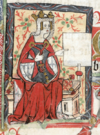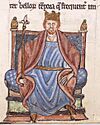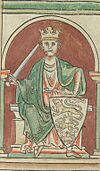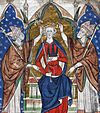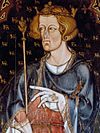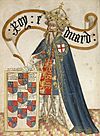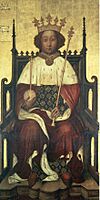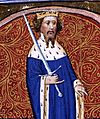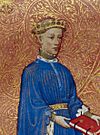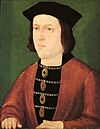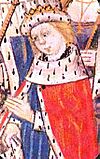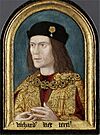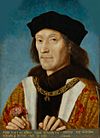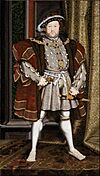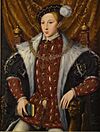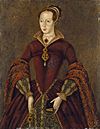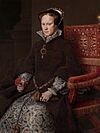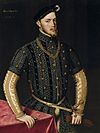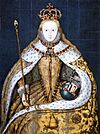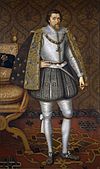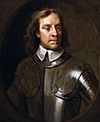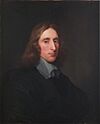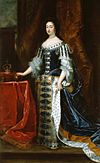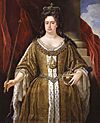List of English monarchs facts for kids
Quick facts for kids Monarchy of England |
|
|---|---|
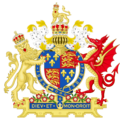
|
|
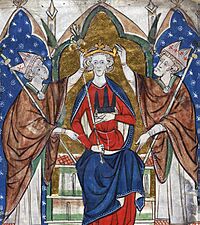
|
|
| Details | |
| First monarch | Alfred the Great |
| Last monarch | Anne |
| Formation | c. 886 (late 9th century) |
| Abolition | 1 May 1707 |
| Residence | Court of St James's |
This list is about the kings and queens who ruled the Kingdom of England. It starts with Alfred the Great. He first ruled Wessex, one of the seven Anglo-Saxon kingdoms. These kingdoms later joined together to form modern England.
Alfred called himself king of the Anglo-Saxons around 886. He wasn't the first king to claim rule over all the English people. But his reign began the first unbroken line of kings to rule all of England. This was the House of Wessex.
Some historians debate who was the first true king of England. For example, Offa of Mercia and Egbert of Wessex are sometimes called kings of England. However, most historians today don't believe their rule led to a unified England.
Historian Simon Keynes said that Offa wanted power, not a united England. Offa's rule over southern England in the late 700s didn't last after his death in 796. Egbert of Wessex also conquered Mercia in 829 but soon lost control.
By the late 800s, Wessex became the strongest Anglo-Saxon kingdom. Its king, Alfred the Great, was the main ruler of western Mercia. He used the title King of the Angles and Saxons. But he didn't rule eastern and northern England. This area was called the Danelaw, controlled by the Danes.
His son, Edward the Elder, conquered the eastern Danelaw. Edward's son, Æthelstan, became the first king to rule all of England. He conquered Northumbria in 927. Many modern historians see him as the first true king of England.
The title "King of the English" or Rex Anglorum in Latin, was first used for Æthelstan in 928. This was the main title for monarchs until King John. In 1016, Cnut the Great, a Dane, was the first to call himself "King of England".
During the Norman period, "King of the English" was still common. But "King of England" or Rex Anglie was sometimes used. From King John's time onwards, "King" or "Queen of England" became the only title.
The Principality of Wales became part of the Kingdom of England in 1284. This happened under the Statute of Rhuddlan. In 1301, King Edward I made his oldest son, who would become King Edward II, the first Prince of Wales. Since then, the oldest sons of English monarchs have held this title.
After Queen Elizabeth I died in 1603 without children, her cousin King James VI of Scotland became King James I of England. This joined the crowns of England and Scotland in a personal union. King James called himself "King of Great Britain". However, a single kingdom wasn't created until 1707.
In 1707, England and Scotland united during the reign of Queen Anne. They formed the new Kingdom of Great Britain. This new kingdom had one British parliament in Westminster. This event marked the end of the Kingdom of England as a separate country.
Contents
- House of Wessex (886–1013)
- House of Denmark (1013–1014)
- House of Wessex (restored, first time) (1014–1016)
- House of Denmark (restored) (1016–1042)
- House of Wessex (restored, second time) (1042–1066)
- House of Godwin (1066)
- House of Normandy (1066–1135)
- House of Blois (1135–1154)
- House of Plantagenet (1154–1485)
- House of Tudor (1485–1603)
- House of Stuart (1603–1649)
- First Interregnum (1649–1660)
- House of Stuart (restored) (1660–1707)
- Acts of Union
- Timeline of English Monarchs
- Royal Titles of English Monarchs
- See also
House of Wessex (886–1013)
| Name | Portrait | Birth | Marriages | Death | Claim |
|---|---|---|---|---|---|
| Alfred Alfred the Great (King of Wessex from 871) c. 886 – 26 October 899 (13 years) |
849
Son of Æthelwulf of Wessex and Osburh |
Ealhswith of Gainsborough 868 5 children |
26 October 899 Aged about 50 |
Son of Æthelwulf of Wessex
Treaty of Wedmore |
|
| Edward the Elder 26 October 899 – 17 July 924 (24 years, 266 days) |
c. 874
Son of Alfred and Ealhswith |
(1) Ecgwynn c. 893 2 children (2) Ælfflæd c. 900 8 children (3) Eadgifu of Kent c. 919 4 children |
17 July 924 Aged about 50 |
Son of Alfred |
Who was Ælfweard of Wessex?
There is some debate about Ælfweard of Wessex. Some evidence suggests he might have been king in 924. This was between his father Edward the Elder and his brother Æthelstan. He was not crowned.
One old list of kings says he ruled for four weeks. Another old record says he died just 16 days after his father. Not all historians agree that he ruled. It's also unclear if he ruled all of England or just Wessex. One idea is that Ælfweard was king in Wessex and Æthelstan in Mercia when their father died.
| Name | Portrait | Birth | Marriages | Death | Claim |
|---|---|---|---|---|---|
| Ælfweard c. 17 July 924 – 2 August 924 (16 days) |
c. 901
Son of Edward the Elder and Ælfflæd |
Unmarried? No children |
2 August 924 Aged about 23 |
Son of Edward the Elder |
| Name | Portrait | Birth | Marriages | Death | Claim |
|---|---|---|---|---|---|
| Æthelstan Æthelstan the Glorious 924 King of the Anglo-Saxons (924–927) – King of the English (927–939) 27 October 939 (14–15 years) |
894
Son of Edward the Elder and Ecgwynn |
Unmarried | 27 October 939 Aged about 45 |
Son of Edward the Elder | |
| Edmund I Edmund the Magnificent 27 October 939 – 26 May 946 (6 years, 212 days) |
c. 921
Son of Edward the Elder and Eadgifu of Kent |
(1) Ælfgifu of Shaftesbury 2 sons (2) Æthelflæd of Damerham 944 No children |
26 May 946 Pucklechurch Died aged about 25 |
Son of Edward the Elder | |
| Eadred 26 May 946 – 23 November 955 (9 years, 182 days) |
c. 923
Son of Edward the Elder and Eadgifu of Kent |
Unmarried | 23 November 955 Frome Aged about 32 |
Son of Edward the Elder | |
| Eadwig Eadwig All-Fair 23 November 955 – 1 October 959 (3 years, 313 days) |
c. 940
Son of Edmund I and Ælfgifu of Shaftesbury |
Ælfgifu No verified children |
1 October 959 Aged about 19 |
Son of Edmund I | |
| Edgar the Peaceful 1 October 959 – 8 July 975 (15 years, 281 days) |
c. 943 Wessex Son of Edmund I and Ælfgifu of Shaftesbury |
(1) Æthelflæd c. 960 1 son (2) Ælfthryth c. 964 2 sons |
8 July 975 Winchester Aged 31 |
Son of Edmund I | |
| Edward the Martyr 8 July 975 – 18 March 978 (2 years, 254 days) |
c. 962
Son of Edgar the Peaceful and Æthelflæd |
Unmarried | 18 March 978 Corfe Castle Died aged about 16 |
Son of Edgar the Peaceful | |
| (1st reign) Æthelred the Unready 18 March 978 – 1013 (34–35 years) |
c. 966
Son of Edgar the Peaceful and Ælfthryth |
(1) Ælfgifu of York 991 9 children (2) Emma of Normandy 1002 3 children |
23 April 1016 London Aged about 48 |
Son of Edgar the Peaceful |
House of Denmark (1013–1014)
England came under the rule of Sweyn Forkbeard, a Danish king. This happened after an invasion in 1013. During this time, Æthelred left the throne and went to Normandy.
| Name | Portrait | Birth | Marriages | Death | Claim |
|---|---|---|---|---|---|
| Sweyn Sweyn Forkbeard 25 December 1013 – 3 February 1014 (41 days) |
17 April 963 Denmark Son of Harald Bluetooth and either Tove or Gunhild |
(1) Gunhild of Wenden c. 990 7 children (2) Sigrid the Haughty c. 1000 1 daughter |
3 February 1014 Gainsborough Aged 50 |
Conquered the land (great-grandson of a king of Northumbria) |
House of Wessex (restored, first time) (1014–1016)
After Sweyn Forkbeard died, Æthelred the Unready came back from exile. He was made king again on February 3, 1014. His son became king after him. He was chosen by the people of London and part of the Witenagemot. This happened even with the Danes trying to take the crown from the West Saxons.
| Name | Portrait | Birth | Marriages | Death | Claim |
|---|---|---|---|---|---|
| (2nd reign) Æthelred the Unready 3 February 1014 – 23 April 1016 (2 years, 81 days) |
c. 966
Son of Edgar the Peaceful and Ælfthryth |
(1) Ælfgifu of York 991 9 children (2) Emma of Normandy 1002 3 children |
23 April 1016 London Aged about 48 |
Son of Edgar the Peaceful | |
| Edmund Ironside 23 April 1016 – 30 November 1016 (222 days) |
c. 990
Son of Æthelred and Ælfgifu of York |
Edith of East Anglia 2 children |
30 November 1016 Glastonbury Aged 26 |
Son of Æthelred |
House of Denmark (restored) (1016–1042)
After the important Battle of Assandun on October 18, 1016, King Edmund made a deal with Cnut (Canute). This deal meant Cnut would control all of England except Wessex. When Edmund died just over a month later, Cnut ruled the whole kingdom as its only king for nineteen years.
| Name | Portrait | Birth | Marriages | Death | Claim |
|---|---|---|---|---|---|
| Cnut Cnut the Great 18 October 1016 – 12 November 1035 (19 years, 26 days) |
c. 995
Son of Sweyn Forkbeard and Gunhilda of Poland |
(1) Ælfgifu of Northampton 2 sons (2) Emma of Normandy 1017 2 children |
12 November 1035 Shaftesbury Aged about 40 |
Son of Sweyn
Treaty of Deerhurst |
|
| Harold Harefoot 12 November 1035 – 17 March 1040 (4 years, 127 days) |
c. 1016
Son of Cnut the Great and Ælfgifu of Northampton |
Ælfgifu? 1 son? |
17 March 1040 Oxford Aged about 24 |
Son of Cnut the Great | |
| Harthacnut 17 March 1040 – 8 June 1042 (2 years, 84 days) |
1018
Son of Cnut the Great and Emma of Normandy |
Unmarried | 8 June 1042 Lambeth Aged about 24 |
Son of Cnut the Great |
House of Wessex (restored, second time) (1042–1066)
After Harthacnut, the Saxon kings returned to power between 1042 and 1066.
| Name | Portrait | Birth | Marriages | Death | Claim |
|---|---|---|---|---|---|
| Edward the Confessor 8 June 1042 – 5 January 1066 (23 years, 212 days) |
c. 1003 Islip Son of Æthelred and Emma of Normandy |
Edith of Wessex 23 January 1045 No children |
5 January 1066 Westminster Palace Aged about 63 |
Son of Æthelred |
House of Godwin (1066)
| Name | Portrait | Birth | Marriages | Death | Claim |
|---|---|---|---|---|---|
| Harold II Harold Godwinson 6 January 1066 – 14 October 1066 (282 days) |
c. 1022
Son of Godwin of Wessex and Gytha Thorkelsdóttir |
(1) Edith Swannesha 5 children (2) Ealdgyth c. 1064 2 sons |
14 October 1066 Hastings Died in the Battle of Hastings aged 44 |
Named heir by Edward the Confessor
Brother-in-law of Edward the Confessor Chosen by the Witenagemot |
Who was Edgar Ætheling?
After King Harold died at the Battle of Hastings, the Witan chose Edgar Ætheling as king. But the Normans had taken control of the country. Edgar never ruled as king. He gave up his claim to King William the Conqueror.
| Name | Portrait | Birth | Marriages | Death | Claim |
|---|---|---|---|---|---|
| (Title disputed) Edgar Ætheling 15 October 1066 – 17 December 1066 (64 days) |
c. 1051
Son of Edward the Exile and Agatha |
No known marriage | 1125 or 1126 Aged about 75 |
Grandson of Edmund Ironside
Chosen by the Witenagemot |
House of Normandy (1066–1135)
In 1066, several people claimed the English throne. These included Harold Godwinson, Harald Hardrada of Norway, and Duke William II of Normandy. Harald and William both invaded England in 1066. Harold Godwinson defeated Harald, but then lost the throne to William in the Norman conquest of England.
After the Battle of Hastings on October 14, 1066, William the Conqueror moved the capital from Winchester to London. William was crowned King William I of England on Christmas Day 1066. This happened in Westminster Abbey. He is known as William the Conqueror or William I.
| Name | Portrait | Birth | Marriages | Death | Claim |
|---|---|---|---|---|---|
| William I William the Conqueror 25 December 1066 – 9 September 1087 (20 years, 259 days) |
c. 1028 Falaise Castle Son of Robert the Magnificent and Herleva |
Matilda of Flanders Normandy 1053 9 children |
9 September 1087 Rouen Aged about 59 |
Named heir in 1052 by Edward the Confessor
Cousin of Edward the Confessor Conquered the land |
|
| William II William Rufus 26 September 1087 – 2 August 1100 (12 years, 311 days) |
c. 1056 Normandy Son of William the Conqueror and Matilda of Flanders |
Unmarried | 2 August 1100 New Forest Died aged 44 |
Son of William I
Given the Kingdom of England over his older brother Robert Curthose |
|
| Henry I Henry Beauclerc 5 August 1100 – 1 December 1135 (35 years, 119 days) |
September 1068 Selby Son of William the Conqueror and Matilda of Flanders |
(1) Matilda of Scotland Westminster Abbey 11 November 1100 2 children (2) Adeliza of Louvain Windsor Castle 29 January 1121 No children |
1 December 1135 Saint-Denis-en-Lyons Aged 67 |
Son of William I
Took the Crown (from Robert Curthose) |
House of Blois (1135–1154)
Henry I had no legal sons to take over. His son William Adelin died in the White Ship disaster of 1120. This ended the direct Norman line of kings. Henry named his oldest daughter, Matilda, as his heir. Before this, he had talked about naming his nephew Stephen of Blois as his heir.
When Henry died, Stephen went to England. He quickly had himself crowned instead of Matilda. The time that followed is known as The Anarchy. Supporters of both sides fought in England and Europe for almost twenty years.
| Name | Portrait | Birth | Marriages | Death | Claim |
|---|---|---|---|---|---|
| Stephen Stephen of Blois 22 December 1135 – 25 October 1154 (18 years, 308 days) |
c. 1096 Blois Son of Stephen II of Blois and Adela of Normandy |
Matilda of Boulogne Westminster 1125 6 children |
25 October 1154 Dover Castle Aged about 58 |
Grandson of William I
Took the throne |
Who was Empress Matilda?
Matilda was named the next in line by her father, Henry I. This happened after her brother died. The barons (important noblemen) agreed to this. But when Henry I died, Matilda's cousin, Stephen of Blois, took the throne.
During the Anarchy that followed, Matilda controlled England for a few months in 1141. She was the first woman to do this. However, she was never crowned queen. Because of this, she is rarely listed as a monarch of England.
| Name | Portrait | Birth | Marriages | Death | Claim |
|---|---|---|---|---|---|
| Matilda Empress Matilda 7 April 1141 – 1 November 1141 (209 days) |
7 February 1102 Sutton Courtenay Daughter of Henry I and Edith of Scotland |
(1) Henry V of the Holy Roman Empire Mainz 6 January 1114 No children (2) Geoffrey V of Anjou Le Mans Cathedral 22 May 1128 3 sons |
10 September 1167 Rouen Aged 65 |
Daughter of Henry I
Took the Crown |
Count Eustace IV of Boulogne (c. 1130 – August 17, 1153) was named co-king by his father, King Stephen. This happened on April 6, 1152. Stephen wanted to make sure Eustace would become king next. This was a custom in France, but not in England. The Pope and the Church did not agree to this. Eustace was never crowned. He died the next year at age 23, before his father. So he never became king on his own.
House of Plantagenet (1154–1485)
The House of Plantagenet gets its name from Geoffrey Plantagenet, Count of Anjou. He was the husband of Empress Matilda and father of Henry II. The name Plantagenet wasn't used as a family name until the 1400s. Richard of York started using it then. Since then, it has been used for English monarchs from Henry II onwards.
Many modern historians call Henry II and his sons the "Angevins". This is because of their large empire in Europe. Most Angevin kings before John spent more time in their European lands than in England.
Angevin Kings of England
King Stephen and Matilda made an agreement in November 1153. This was the Treaty of Wallingford. In it, Stephen agreed that Henry would be the next king. Henry was the son of Matilda and her second husband, Geoffrey Plantagenet, Count of Anjou.
The royal family that came from Matilda and Geoffrey is known by two names. They are the House of Anjou (from Geoffrey's title as Count of Anjou) or the House of Plantagenet. Some historians divide these kings into two groups. This is based on whether they still held most of their French lands.
The Angevins (meaning "from Anjou" in French) ruled a large area from the Pyrenees to Ireland. This was in the 1100s and 1200s. They did not see England as their main home. This changed after King John lost most of their lands in Europe.
The direct line from Henry II includes kings known as the House of Plantagenet. Later branches of this family became the House of Lancaster and the House of York. This happened during the War of the Roses.
The Angevins created England's royal coat of arms. This coat of arms usually showed other kingdoms they ruled or claimed. The motto Dieu et mon droit (meaning "God and my right") was first used by Richard I. He used it as a battle cry in 1198. It has been the motto of English monarchs since Edward III adopted it.
| Name | Portrait | Arms | Birth | Marriages | Death | Claim | ||||||||||||||||||||||||||||||||||||||||||||||||||||||||||||||||||||||||||||||||||||||||||||
|---|---|---|---|---|---|---|---|---|---|---|---|---|---|---|---|---|---|---|---|---|---|---|---|---|---|---|---|---|---|---|---|---|---|---|---|---|---|---|---|---|---|---|---|---|---|---|---|---|---|---|---|---|---|---|---|---|---|---|---|---|---|---|---|---|---|---|---|---|---|---|---|---|---|---|---|---|---|---|---|---|---|---|---|---|---|---|---|---|---|---|---|---|---|---|---|---|---|---|
| Henry II Henry Curtmantle 19 December 1154 – 6 July 1189 (34 years, 200 days) |
 |
5 March 1133 Le Mans Son of Geoffrey V of Anjou and Matilda |
Eleanor of Aquitaine Bordeaux Cathedral 18 May 1152 8 children |
6 July 1189 Chinon Aged 56 |
Grandson of Henry I
Treaty of Wallingford Great-great-great-grandson of Edmund Ironside |
|||||||||||||||||||||||||||||||||||||||||||||||||||||||||||||||||||||||||||||||||||||||||||||
| Henry II named his son, Henry the Young King (1155–1183), as a co-ruler. This was a Norman custom to show who would be king next. The younger Henry died before his father. So he did not rule on his own and is not counted as a monarch. | ||||||||||||||||||||||||||||||||||||||||||||||||||||||||||||||||||||||||||||||||||||||||||||||||||
| Richard I Richard the Lionheart 3 September 1189 – 6 April 1199 (9 years, 216 days) |
 |
8 September 1157 Beaumont Palace Son of Henry II and Eleanor of Aquitaine |
Berengaria of Navarre Limassol 12 May 1191 No children |
6 April 1199 Châlus Died aged 41 |
Son of Henry II
Firstborn son |
|||||||||||||||||||||||||||||||||||||||||||||||||||||||||||||||||||||||||||||||||||||||||||||
| John John Lackland 27 May 1199 – 19 October 1216 (17 years, 146 days) |
24 December 1166 Beaumont Palace Son of Henry II and Eleanor of Aquitaine |
(1) Isabel of Gloucester Marlborough Castle 29 August 1189 No children (2) Isabella of Angoulême Bordeaux Cathedral 24 August 1200 5 children |
19 October 1216 Newark-on-Trent Aged 49 |
Son of Henry II
Chosen as heir Closest relative |
||||||||||||||||||||||||||||||||||||||||||||||||||||||||||||||||||||||||||||||||||||||||||||||
Who was Louis VIII of France?
The future Louis VIII of France briefly controlled two-thirds of England. This was from May 1216 to September 1217. It happened at the end of the First Barons' War against King John. Prince Louis landed in England on May 21, 1216. He marched to London with little resistance. People cheered for him.
On June 2, 1216, in St. Paul's Cathedral, Prince Louis was declared King Louis of England. Many English clergy and nobles were there, as was the Mayor of London. In less than a month, "King Louis" controlled over half the country. Two-thirds of the barons supported him. However, he lost a battle against the English fleet.
By signing the Treaty of Lambeth in September 1217, Louis received money. He also agreed that he had never been the true king of England. "King Louis" is one of the less known kings who ruled a large part of England.
| Name | Portrait | Arms | Birth | Marriages | Death | Claim |
|---|---|---|---|---|---|---|
| Louis Louis the Lion 2 June 1216 – 20 September 1217 (1 year, 111 days) |
 |
5 September 1187 Paris Son of Philip II of France and Isabella of Hainault |
Blanche of Castile Port-Mort 23 May 1200 13 children |
8 November 1226 Montpensier Aged 39 |
Conquered the land
Offered the crown by the Barons |
Main Line of Plantagenets
From the time of Henry III, the Plantagenet kings became more English. This was after they lost most of their lands in Europe. The Houses of Lancaster and York are related branches of the Plantagenet family.
| Name | Portrait | Arms | Birth | Marriages | Death | Claim |
|---|---|---|---|---|---|---|
| Henry III Henry of Winchester 28 October 1216 – 16 November 1272 (56 years, 20 days) |
 |
1 October 1207 Winchester Castle Son of John and Isabella of Angoulême |
Eleanor of Provence Canterbury Cathedral 14 January 1236 5 children |
16 November 1272 Westminster Palace Aged 65 |
Son of John
Firstborn son |
|
| Edward I Edward Longshanks 20 November 1272 – 7 July 1307 (34 years, 230 days) |
17 June 1239 Palace of Westminster Son of Henry III and Eleanor of Provence |
(1) Eleanor of Castile Abbey of Santa María la Real de Las Huelgas 18 October 1254 16 children (2) Margaret of France Canterbury 10 September 1299 3 children |
7 July 1307 Burgh by Sands Aged 68 |
Son of Henry III
Firstborn son |
||
| Edward II Edward of Caernarfon 8 July 1307 – Abdicated 20 January 1327 (19 years, 197 days) |
25 April 1284 Caernarfon Castle Son of Edward I and Eleanor of Castile |
Isabella of France Boulogne Cathedral 24 January 1308 4 children |
21 September 1327 Berkeley Castle Died aged 43 |
Son of Edward I
Firstborn son |
||
| Edward III Edward of Windsor 25 January 1327 – 21 June 1377 (50 years, 148 days) |
 Until 1340, 1360–1369  1340–1360, from 1369 |
13 November 1312 Windsor Castle Son of Edward II and Isabella of France |
Philippa of Hainault York Minster 25 January 1328 14 children |
21 June 1377 Sheen Palace Aged 64 |
Son of Edward II
Firstborn son |
|
| Richard II Richard of Bordeaux 22 June 1377 – 29 September 1399 (22 years, 100 days) |
 |
6 January 1367 Bordeaux Son of Edward the Black Prince and Joan of Kent |
(1) Anne of Bohemia 14 January 1382 No children (2) Isabella of Valois Calais 4 November 1396 No children |
14 February 1400 Pontefract Castle Aged 33 |
Grandson of Edward III
Firstborn son |
House of Lancaster
This royal family came from John of Gaunt. He was Edward III's third son who lived to adulthood. Henry IV took power from Richard II. He also took the place of Edmund Mortimer, who was next in line. Edmund was a descendant of Edward III's second son, Lionel of Antwerp.
| Name | Portrait | Arms | Birth | Marriages | Death | Claim |
|---|---|---|---|---|---|---|
| Henry IV Henry of Bolingbroke 30 September 1399 – 20 March 1413 (13 years, 172 days) |
 until 1406  from 1406 |
c. April 1367 Bolingbroke Castle Son of John of Gaunt and Blanche of Lancaster |
(1) Mary de Bohun Arundel Castle 27 July 1380 6 children (2) Joanna of Navarre Winchester Cathedral 7 February 1403 No children |
20 March 1413 Westminster Abbey Aged 45 |
Grandson of Edward III
Took the throne by force |
|
| Henry V Henry of Monmouth 21 March 1413 – 31 August 1422 (9 years, 164 days) |
 |
16 September 1386 Monmouth Castle Son of Henry IV and Mary de Bohun |
Catherine of Valois Troyes Cathedral 2 June 1420 1 son |
31 August 1422 Château de Vincennes Aged 35 |
Son of Henry IV
Firstborn son |
|
| (1st reign) Henry VI 1 September 1422 – 4 March 1461 (38 years, 185 days) |
 |
6 December 1421 Windsor Castle Son of Henry V and Catherine of Valois |
Margaret of Anjou Titchfield Abbey 22 April 1445 1 son |
21 May 1471 Tower of London Died aged 49 |
Son of Henry V
Firstborn son |
House of York
The House of York claimed the right to the throne through Edward III's second son, Lionel of Antwerp. But the family got its name from Edward's fourth son, Edmund of Langley, the first Duke of York.
The Wars of the Roses (1455–1485) were a series of wars. During these wars, the throne went back and forth between the rival houses of Lancaster and York.
| Name | Portrait | Arms | Birth | Marriages | Death | Claim |
|---|---|---|---|---|---|---|
| (1st reign) Edward IV 4 March 1461 – 3 October 1470 (9 years, 214 days) |
 |
28 April 1442 Rouen Son of Richard of York and Cecily Neville |
Elizabeth Woodville Grafton Regis 1 May 1464 10 children |
9 April 1483 Westminster Palace Aged 40 |
Great-great-grandson of Edward III
Took the Crown Act of Accord |
House of Lancaster (restored)
| Name | Portrait | Arms | Birth | Marriages | Death | Claim |
|---|---|---|---|---|---|---|
| (2nd reign) Henry VI 3 October 1470 – 11 April 1471 (191 days) |
 |
6 December 1421 Windsor Castle Son of Henry V and Catherine of Valois |
Margaret of Anjou Titchfield Abbey 22 April 1445 1 son |
21 May 1471 Tower of London Died aged 49 |
Son of Henry V
Took the Crown |
House of York (restored)
| Name | Portrait | Arms | Birth | Marriages | Death | Claim |
|---|---|---|---|---|---|---|
| (2nd reign) Edward IV 11 April 1471 – 9 April 1483 (11 years, 364 days) |
 |
28 April 1442 Rouen Son of Richard of York and Cecily Neville |
Elizabeth Woodville Grafton Regis 1 May 1464 10 children |
9 April 1483 Westminster Palace Aged 40 |
Great-great-grandson of Edward III
Took the Crown Act of Accord |
|
| Edward V 9 April 1483 – 25 June 1483 (78 days) |
2 November 1470 Westminster Son of Edward IV and Elizabeth Woodville |
Unmarried | Disappeared mid-1483 London Died aged 12 |
Son of Edward IV
Firstborn son |
||
| Richard III 26 June 1483 – 22 August 1485 (2 years, 58 days) |
2 October 1452 Fotheringhay Castle Son of Richard of York and Cecily Neville |
Anne Neville Westminster Abbey 12 July 1472 1 son |
22 August 1485 Bosworth Field Died in battle aged 32 |
Great-great-grandson of Edward III
Titulus Regius |
House of Tudor (1485–1603)
The Tudors were related to the Plantagenets through John Beaufort. He was one of the children of John of Gaunt (Edward III's third son) and his long-time partner Katherine Swynford. Normally, children born outside of marriage wouldn't have a claim to the throne. But John of Gaunt and Katherine Swynford later married in 1396. The church then said the Beauforts were legitimate. Parliament also agreed in 1397.
However, John of Gaunt's other son, King Henry IV, later said the Beauforts could not inherit the throne. Still, the Beauforts stayed close to the Royal House of Lancaster.
John Beaufort's granddaughter, Lady Margaret Beaufort, married Edmund Tudor. Edmund was the son of a Welsh courtier, Owain Tudur, and Catherine of Valois. Catherine was the widow of the Lancastrian King Henry V. Edmund Tudor and his siblings were either born outside of marriage or from a secret marriage. Their success came from the kindness of their half-brother King Henry VI. When the House of Lancaster lost power, the Tudors also faced difficulties.
By the late 1400s, the Tudors were the last hope for the Lancaster supporters. Edmund Tudor's son became king as Henry VII. He defeated Richard III at the Battle of Bosworth Field in 1485. This ended the Wars of the Roses. King Henry married Elizabeth of York, Edward IV's daughter. This brought together the Lancaster and York family lines.
| Name | Portrait | Arms | Birth | Marriages | Death | Claim |
|---|---|---|---|---|---|---|
| Henry VII 22 August 1485 – 21 April 1509 (23 years, 243 days) |
 |
28 January 1457 Pembroke Castle Son of Edmund Tudor and Margaret Beaufort |
Elizabeth of York Westminster Abbey 18 January 1486 8 children |
21 April 1509 Richmond Palace Aged 52 |
Great-great-great-grandson of Edward III
Conquered the land Marriage to Elizabeth of York |
|
| Henry VIII 22 April 1509 – 28 January 1547 (37 years, 282 days) |
28 June 1491 Greenwich Palace Son of Henry VII and Elizabeth of York |
(1) Catherine of Aragon Greenwich 11 June 1509 1 daughter (2) Anne Boleyn Westminster Palace 25 January 1533 1 daughter (3) Jane Seymour Whitehall Palace 30 May 1536 1 son 3 further marriages No more children |
28 January 1547 Whitehall Palace Aged 55 |
Son of Henry VII
Firstborn son |
||
| Edward VI 28 January 1547 – 6 July 1553 (6 years, 160 days) |
12 October 1537 Hampton Court Palace Son of Henry VIII and Jane Seymour |
Unmarried | 6 July 1553 Greenwich Palace Aged 15 |
Son of Henry VIII
Firstborn son |
Who was Lady Jane Grey?
Edward VI named Lady Jane Grey as his heir in his will. This went against the order of who should become king or queen, which Parliament had set. Four days after Edward's death on July 6, 1553, Jane was declared queen. She was the first of three Tudor women to be declared queen.
Nine days after this, on July 19, the Privy Council changed their minds. They declared Edward VI's Catholic half-sister Mary queen instead. Jane was later executed for treason.
| Name | Portrait | Arms | Birth | Marriages | Death | Claim |
|---|---|---|---|---|---|---|
| Jane Lady Jane Grey 10 July 1553 – 19 July 1553 (9 days) |
 |
1536 or 1537 Bradgate Park Daughter of the 1st Duke of Suffolk and Frances Brandon |
Guildford Dudley The Strand 21 May 1553 No children |
12 February 1554 Tower of London Died aged about 17 |
Great-granddaughter of Henry VII
Named heir by Edward VI |
| Name | Portrait | Arms | Birth | Marriages | Death | Claim |
|---|---|---|---|---|---|---|
| Mary I 19 July 1553 – 17 November 1558 (5 years, 122 days) |
 |
18 February 1516 Greenwich Palace Daughter of Henry VIII and Catherine of Aragon |
Philip II of Spain Winchester Cathedral 25 July 1554 No children |
17 November 1558 St James's Palace Aged 42 |
Daughter of Henry VIII
Third Succession Act |
|
| (Jure uxoris) Philip 25 July 1554 – 17 November 1558 (4 years, 116 days) |
21 May 1527 Valladolid Son of Charles V of the Holy Roman Empire and Isabella of Portugal |
Mary I of England Winchester Cathedral 25 July 1554 No children 3 other marriages 7 children |
13 September 1598 El Escorial Aged 71 |
Husband of Mary I
Act for the Marriage of Queen Mary to Philip of Spain |
||
| Elizabeth I 17 November 1558 – 24 March 1603 (44 years, 128 days) |
 |
7 September 1533 Greenwich Palace Daughter of Henry VIII and Anne Boleyn |
Unmarried | 24 March 1603 Richmond Palace Aged 69 |
Daughter of Henry VIII
Third Succession Act |
House of Stuart (1603–1649)
Elizabeth's cousin, King James VI of Scotland, became King James I of England. This was called the Union of the Crowns. James was related to the Tudors through his great-grandmother, Margaret Tudor. She was the oldest daughter of Henry VII and wife of James IV of Scotland. In 1604, James called himself King of Great Britain. But the English and Scottish parliaments stayed separate until the Acts of Union 1707.
| Name | Portrait | Arms | Birth | Marriages | Death | Claim |
|---|---|---|---|---|---|---|
| James I 24 March 1603 – 27 March 1625 (22 years, 4 days) |
 |
19 June 1566 Edinburgh Castle Son of Mary, Queen of Scots, and Henry Stuart, Lord Darnley |
Anne of Denmark Oslo 23 November 1589 7 children |
27 March 1625 Theobalds House Aged 58 |
Great-great-grandson of Henry VII | |
| Charles I 27 March 1625 – 30 January 1649 (23 years, 310 days) |
19 November 1600 Dunfermline Palace Son of James I and Anne of Denmark |
Henrietta Maria of France St Augustine's Abbey 13 June 1625 9 children |
30 January 1649 Whitehall Palace Died aged 48 |
Son of James I
Firstborn son |
First Interregnum (1649–1660)
No monarch ruled after Charles I died in 1649. From 1649 to 1653, England had no single head of state. The country was ruled by the Rump Parliament. The English Council of State acted as the government. This time was known as the Commonwealth of England.
In 1653, Oliver Cromwell took control of England from Parliament. He used military force to end the Rump Parliament. England then entered The Protectorate period. Cromwell ruled directly with the title Lord Protector.
The Lord Protector could choose who would take over after him. Oliver Cromwell chose his oldest son, Richard Cromwell.
| Name | Portrait | Arms | Birth | Marriages | Death |
|---|---|---|---|---|---|
| Oliver Cromwell 16 December 1653 – 3 September 1658 (4 years, 262 days) |
 |
25 April 1599 Huntingdon Son of Robert Cromwell and Elizabeth Steward |
Elizabeth Bourchier St Giles 22 August 1620 9 children |
3 September 1658 Whitehall Aged 59 |
|
| Richard Cromwell 3 September 1658 – 7 May 1659 (247 days) |
4 October 1626 Huntingdon Son of Oliver Cromwell and Elizabeth Bourchier |
Dorothy Maijor May 1649 9 children |
12 July 1712 Cheshunt Aged 85 |
Richard Cromwell was removed from power by the English Committee of Safety in May 1659. England again had no single head of state. After almost a year of disorder, the monarchy was brought back. This was called the Stuart Restoration. Charles II returned from France to become king.
House of Stuart (restored) (1660–1707)
The monarchy was restored with Charles II as king.
| Name | Portrait | Arms | Birth | Marriages | Death | Claim |
|---|---|---|---|---|---|---|
| Charles II 29 May 1660 – 6 February 1685 (24 years, 254 days) |
 |
29 May 1630 St James's Palace Son of Charles I and Henrietta Maria of France |
Catherine of Braganza Portsmouth 21 May 1662 No children |
6 February 1685 Whitehall Palace Aged 54 |
Son of Charles I
Firstborn son English Restoration |
|
| James II 6 February 1685 – 23 December 1688 (Overthrown after 3 years, 321 days) |
14 October 1633 St James's Palace Son of Charles I and Henrietta Maria of France |
(1) Anne Hyde The Strand 3 September 1660 8 children (2) Mary of Modena Dover 21 November 1673 7 children |
16 September 1701 Château de Saint-Germain-en-Laye Aged 67 |
Son of Charles I
Firstborn son |
Second Interregnum 1688–1689
James II was removed from power by Parliament less than four years after becoming king. This started the second period without a monarch in the century. To decide who should replace the king, a Convention Parliament met. They chose James's daughter Mary II and her husband (who was also his nephew) William III to rule together. This event is known as the Glorious Revolution.
Houses of Stuart and Orange
| Name | Portrait | Arms | Birth | Marriages | Death | Claim |
|---|---|---|---|---|---|---|
| Mary II 13 February 1689 – 28 December 1694 (5 years, 319 days) |
 |
30 April 1662 St James's Palace Daughter of James II and Anne Hyde |
William III of England St James's Palace 4 November 1677 No children |
28 December 1694 Kensington Palace Aged 32 |
Daughter of James II
Offered the Crown by Parliament |
|
| William III William of Orange 13 February 1689 – 8 March 1702 (13 years, 24 days) |
 |
4 November 1650 The Hague Son of William II of Orange and Mary of England |
Mary II of England St James's Palace 4 November 1677 No children |
8 March 1702 Kensington Palace Aged 51 |
Grandson of Charles I
Offered the Crown by Parliament |
|
| Anne 8 March 1702 – 1 May 1707 (5 years, 55 days) (Queen of Great Britain until 1 August 1714) (12 years, 147 days) |
 |
6 February 1665 St James's Palace Daughter of James II and Anne Hyde |
George of Denmark St James's Palace 28 July 1683 3 children |
1 August 1714 Kensington Palace Aged 49 |
Daughter of James II
Firstborn daughter Bill of Rights 1689 |
Even though James II and his family still claimed the throne, Catholics were not allowed to be king or queen. This rule was set by the Act of Settlement 1701. It was passed by Queen Anne, another of James's Protestant daughters.
With the Acts of Union 1707, England stopped being a separate country. It became part of the new Kingdom of Great Britain. For more information, see List of British monarchs.
Acts of Union
The Acts of Union 1707 were two laws passed in 1706 and 1707. They were passed by the Parliament of England and the Parliament of Scotland. These laws made the Treaty of Union official. The acts joined the Kingdom of England and the Kingdom of Scotland. Before this, they were separate countries with their own parliaments. But they had the same monarch. They became the Kingdom of Great Britain.
England, Scotland, and Ireland had shared a monarch for over a hundred years. This started with the Union of the Crowns in 1603. That's when King James VI of Scotland also became king of England and Ireland. Even though it was called a Union of Crowns, until 1707, there were still two separate crowns on the same head.
There were attempts to unite England and Scotland in 1606, 1667, and 1689. But these attempts didn't work. It wasn't until the early 1700s that both governments supported the idea. They had different reasons for wanting the union.
Timeline of English Monarchs
| Timeline of English monarchs |
|---|
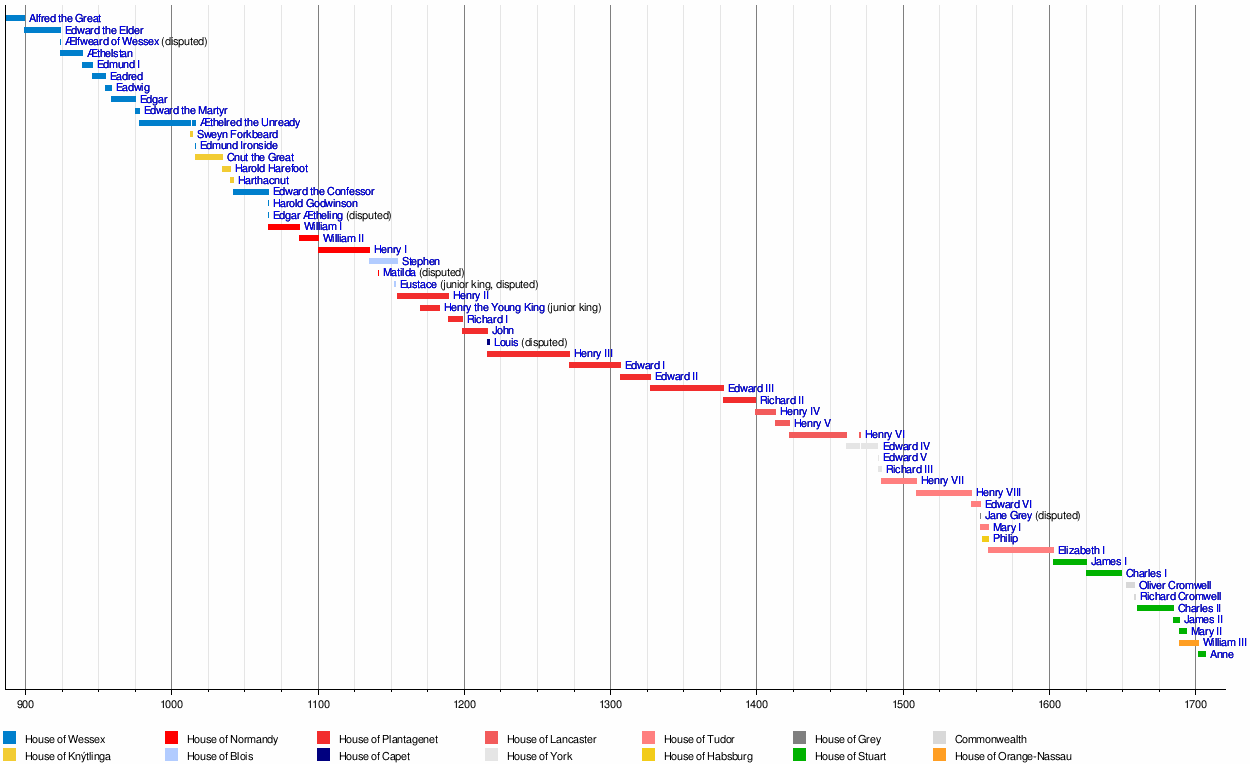 |
Royal Titles of English Monarchs
The main title for all kings from Æthelstan until King John was Rex Anglorum ("King of the English"). Many kings before the Normans also used extra titles:
- Æthelstan: Rex totius Britanniae ("King of the Whole of Britain")
- Edmund the Magnificent: Rex Britanniæ ("King of Britain")
- Eadred: Regis qui regimina regnorum Angulsaxna, Norþhymbra, Paganorum, Brettonumque ("Reigning over the governments of the kingdoms of the Anglo-Saxons, Northumbrians, Pagans, and British")
- Eadwig the Fair: Rex nutu Dei Angulsæxna et Northanhumbrorum imperator paganorum gubernator Breotonumque propugnator ("King by the will of God, Emperor of the Anglo-Saxons and Northumbrians, governor of the pagans, commander of the British")
- Edgar the Peaceful: Totius Albionis finitimorumque regum basileus ("King of all Albion and its neighbouring realms")
- Cnut the Great: Rex Anglorum totiusque Brittannice orbis gubernator et rector ("King of the English and of all the British sphere governor and ruler") and Brytannie totius Anglorum monarchus ("Monarch of all the English of Britain")
During the Norman period, Rex Anglorum was still common. Sometimes Rex Anglie ("King of England") was used. The Empress Matilda called herself Domina Anglorum ("Lady of the English").
From King John onwards, the only titles used were Rex or Regina Anglie (King or Queen of England).
In 1604, James I became king of England. He had inherited the English throne the year before. He started using the title King of Great Britain. But the English and Scottish parliaments didn't officially accept this title until the Acts of Union in 1707. This happened under Queen Anne. She was Queen of Great Britain, not king.
See also
 In Spanish: Anexo:Reyes de Inglaterra para niños
In Spanish: Anexo:Reyes de Inglaterra para niños
- Alternative successions of the English and British crown
- Bretwalda
- Demise of the Crown
- Heptarchy
- History of monarchy in the United Kingdom
- Succession to the British throne, a historical overview and current rules
- Succession to the British throne § Current line of succession, a list of people
- List of English royal consorts
- Family tree of English monarchs
- Family tree of British monarchs
- List of office holders of the United Kingdom and predecessor states
- Mnemonic verses of monarchs in England
- List of legendary kings of Britain






